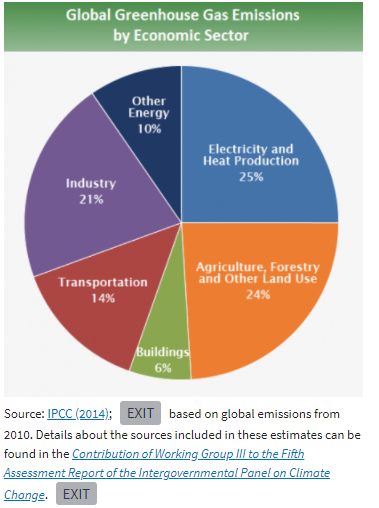Is his math wrong about the need to install a *lot* of electrical power fairly quickly? "Climate change" and "electric cars" are separate topics.
Replacing billions of individual engines with 3+ orders of magnitude less engines at combined less than 30% rated output is a problem?
Umm... YES.
1. The pool of motor vehicles turns over naturally with the lifetime of the vehicle, massive industrial capacity already exists. Think 25 year natural turnover and here is a 10+ year head start.
2. Removing the constrain on scale and field operation and rarely used peak power, standing generators can be optimized to be far more efficient in dimensions of choice due to removed constrains. The fact that unconstrained engines are orders of magnitudes larger than motor vehicle engines shows that existing motor vehicles are very far from the optimal scale. This is reflected that electricity (whose cost includes engine, conversion, transmission and 'noncompetitive market capture cost') is cheaper than gasoline even before counting in the costs of motor vehicle engines.
3. The lack of constraint for electrical generation means just about anything can be made to feed into the grid. Even a hybrid car with some electrical doodads added can feed back into the grid.
Generation, in a broad view, is and will not be the constraint.
The question is whether you can get clean generation and production of sufficient electrical distribution and storage equipment at lowered cost to fulfill demand is still somewhat up in the air. If you successfully identify bottlenecks (long on nickel and copper in 2017?) a killing is to be made.
Electricity is more like an "foundation" to the energy system by enabling efficient usage and fast transmission and conversions everywhere, and it can basically absorb all energy source and consumer within, working with more technology you can imagine. The success of the electrical grid as a technology up to this point, displacing all static heat engines at this point, means it is unwise to bet against it.
The history of the post industrial revolution world is relentless growth that finds ways around all constraints. In term of crisis, the 1960s projections of billions of death due to famine was far more actually threatening, but green revolution goes burrrrrr
Unlike previous crisis that demands new production, this is a replacement of an old system that consumed very significant human and other resources: Pictured: a oil sand mine. To think, dig a hole in the ground only to use it up the resource once. Compare that to production of machines that can be used for decades before being recycled.
"First, they say no fossil fuel cars after 2035. In the US we drive 3.2 trillion miles per year. Electric cars use ~0.3 kwh/mile. We'll need to build a 1 GW nuclear plant every three weeks starting tomorrow JUST for the extra electricity to charge the cards."
"But it's much worse than that. That's just US sparky cars. To completely get the globe off of fossil fuels by 2050, we'd have to build two 2.1 GW nuclear plants EVERY SINGLE DAY FROM NOW TO 2050. The IEA is a sick joke. WE CAN'T GET THERE!!!"
The problem isn't seen as a real one, because it has historically be solved so well. It is precisely because all the gigawatts up to this point is so invisible to the average upper middle class urban voter that all kind of grandstanding can exist. Compare that with smog, which gets banned and even the Chinese leadership that don't really care about carbon is pushing EVs because breathing Beijing air is obviously unfitting for the new master of the universe. (coal plants in xinjian? lol to them) If electricity prices is really hitting the motivation of that class of people (direct access to the media), building will happen.
The world actually have excess in resources. Just think, some thing like 50+% of the economy is employed in pushing paper to each other and 'virtual' thingys. The smartest people in the generation is building advertising platforms because the big problem is people not buying more stuff rather than making stuff.
"Trivial" means of increasing the production of stuff is known forever, and not pursued because people don't want it. If resources are mobilized like it were ww2 again...oh oh
-------------------
The "utility" of material objects relative to the human animal beyond what goes into stomach and lungs is ultimately very questionable. On a meta-level stuff is socially calibrated status game, and non-central one to boot. So many generations of humanity lived through far more material poor times just fine. People care about social, political and other games just as much as money.
In some sense, the thing to worry is not about the industrial system failing to regrow to fill current capacity, but it succeeding too much and throwing everyone's lives into chaos.
The motor vehicle has been a defining force of geography and society for more than a generation. Fleets of autonomous aerial vehicles have potential reshape society. We don't know what that looks like at all, and it could be bad.















